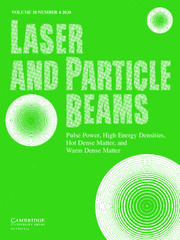Article contents
Influence of laser beam intensity profile on propagation dynamics of laser-blow-off plasma plume
Published online by Cambridge University Press: 11 June 2010
Abstract
Effect of intensity profile of the ablating laser on the dynamics of laser-blow-off (LBO) plume has been studied by fast imaging technique. This work emphasizes the geometrical aspect of the LBO plume, which is an important parameter for various applications. Visualization of the expanding plume reveals that geometrical shape and directionality (divergence) of the plume are highly dependent on the laser intensity profile. Present results demonstrate that the Gaussian profile laser produces a well-collimated, low divergence plasma plume as compared to the plume formed by a top-hat profile laser. The sequence of film removal processes is invoked to explain the role of energy density profile of the ablating laser in LBO mechanism.
Information
- Type
- Research Article
- Information
- Copyright
- Copyright © Cambridge University Press 2010
References
REFERENCES
- 10
- Cited by

